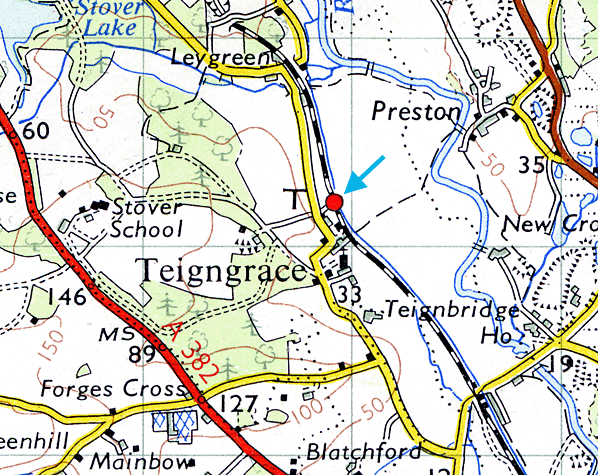|
Notes: Initially on the opening of the line it was felt that due to the size of the local population around Teigngrace (less than 200) a station was not needed, however one of the conditions of sale of the land to the M&SDR was that the land owner, The Duke of Somerset, had secured the right to stop any train at Teigngrace whenever he wished to travel. It therefore seemed the logical thing to provide a station, albeit basic. It consisted of 200ft platform with a booking/parcels office and a lavatory. The drive to Stover House begins opposite the approach road. The station was provided with a single siding which was sometimes used for loading ball clay.
Following gauge conversion in 1892 the platform was lengthened by 52 feet towards Newton Abbot. It was reached by a tree lined driveway from the public road.
The station was closed as an economy measure in WW1 between 1.1.1917 - 1.5.1919. The station was unstaffed from 8th May 1939 and hence demoted to halt status. Goods facilities were withdrawn on the same day
BRIEF HISTORY OF THE MORETONHAMSTEAD BRANCH
The line ran from the main line at Newton Abbot and following the valleys of the rivers Teign and Bovey some 12 miles to the terminus at Moretonhampstead; rising to a height of over 500ft to the edge of Dartmoor. From just south of Bovey to Teigngrace the line also followed the route of Devon’s first permanent railway, the Haytor Tramway which was used to transport granite from Haytor on Dartmoor towards the docks at Teignmouth. The railways tracks were constructed totally of stone.
The Moreton & South Devon Railway Company Act was passed in 1862 for a broad gauge line from Newton Abbot to Moretonhampstead. Local people were slow to subscribe and bad weather delayed construction with the line finally opening on 4th July 1866. From the outset, the service was provided by the South Devon Railway who absorbed the local company in 1872. The bridges on the line were constructed for double track but never used as such. Goods traffic began on the line on 8th October, three months after the line opened to passengers. Initially the service was poor and traffic was sparse until the end of the century by which time the line was well used. The South Devon Railway was absorbed by the GWR in 1878 and the line was converted from broad gauge to standard gauge between 20th and 23rd May 1892.
In 1906 the GWR began running busses from Moretonhampstead to Chagford in connection with the trains and as the Torbay resorts grew in popularity visitors flocked to the railway. Despite road competition the branch was busy until WW2 but no effort was made to attract business back to the line after the war.
British Railways claimed that the line was losing over £17,000 a year so it was announced that passenger service would be withdrawn on 2nd March 1959. This caused much local discussion.
The closure of the Teign Valley line from Exeter in 1958 has hastened the demise of the line with a huge reduction in passenger traffic at the junction station of Heathfield. The last public passenger train left Moretonhampstead on 28th February 1959 ending 92 years continuous service.
Initially freight traffic to Moretonhampstead was retained but this was cut back to Bovey on 6th April 1964. Track lifting north of Bovey commenced in 1965 and was completed on 21st June 1966. The freight service between Heathfield & Bovey was withdrawn on 4th December 1967. The last passenger excursion ran to Bovey on 5th April 1970 with four trains running during the day. Track lifting north of Heathfield was completed by early 1971.
The carriage of fuel oil, ball clay and bananas from Heathfield continued, although Heathfield station was unstaffed after 5th June 1972 and the banana traffic ceased in 1975.
The line had its share of royal visitors over the years, in 1983 The Prince and Princess of Wales spent the night in the royal train just south of Teigngrace. The Prince departed from Teigngrace Halt the following morning whereas the Princess departed from Heathfield, both attending separate engagements.
In 1986 construction of the Bovey bypass started following the route of the track from just North of Bovey station down through Brimley and on towards pottery bridge.
After 1996 the remaining section of line was virtually abandoned with only two passenger excursions visiting the line in 1997, but in 1998 a once weekly service was introduced between Newton Abbot and Timber Siding at Heathfield taking ball clay away from a local pit where it is still mined. Occasional passenger excursions still visit Heathfield, most recently on 25.5.2002.
Further reading:
Branch Line to Moretonhampstead (including Heathfield - Exeter) by Vic Mitchell & Keith Smith
Middleton Press 1998 ISBN 1 901706 273
Walking West Country Railways by Christopher Somerville - David & Charles 1979
ISBN 0 715381421
The Moretonhampstead Branch: A railway from shore to moor by John Owen published by Waterfront, ISBN 0-946184-88-7.
The Newton Abbot to Moretonhampstead Railway by Anthony Kingdom, Mike Lang & Eric Shepherd published 2004 by Ark Publications ISBN 1 873029 09 08
Great Western Branch Line Termini by Paul Karau, published 1999 by Oxford Publishing ISBN 0 86093 369 5
Branch Lines of Devon by Colin Maggs
- Sutton Publishing 1995 ISBN 1 84015 022x
Other web sites: Moretonhampstead History Society
To see other stations on the Moretonhampstead
branch click on the station name: Heathfield, Brimley Halt, Bovey, Pullabrook Halt, Lustleigh & Moretonhampstead
|

old1.jpg)

10.jpg)
 Home Page
Home Page 
old1.jpg)

10.jpg)
 Home Page
Home Page